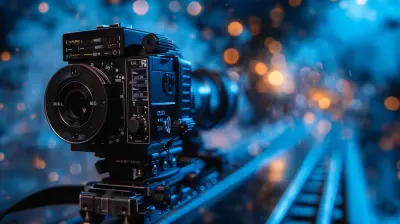How to Enhance Audio in Your Video Editing Projects
9 November 2025
If you're diving into video editing, chances are you've spent hours perfecting your footage — cutting, splicing, color grading, adding transitions. But what about the audio? It's easy to overlook, but let’s be real: bad audio can ruin even the most beautifully shot video. It doesn't matter how cinematic your shots look if your viewers can't hear the dialogue or are assaulted by background noise.
In this guide, we’re going to walk through how to enhance audio in your video editing projects so your viewers stay hooked — and maybe even impressed enough to hit that share button.

Why Your Audio Matters More Than You Think
Picture this: you're watching a stunning travel vlog. The drone shots are breathtaking, colors are rich, editing is tight. But then… the voiceover sounds like it was recorded inside a tin can. Or worse, the background music drowns out the speaker. Instantly, the magic's gone.Audio isn’t just a supporting player; it’s half the experience. Bad audio jars the viewer out of the story. Good audio? It pulls them in and keeps them there.

The Basic Ingredients of Good Audio
Before we get into the fancy tools and tricks, let’s break down what good audio really means in the context of video:- Clarity: Can I understand what’s being said?
- Consistency: Is the volume steady, or do I have to ride the remote?
- Balance: Do music, voice, and SFX blend well, or is one overpowering the others?
- Atmosphere: Does the audio build emotion and support the visual story?
If you keep these in mind, every decision you make about audio will support your video and elevate the end result.

Capture Clean Audio From the Start
Let’s get one thing straight — post-production is amazing, but it’s not magic. If your audio is garbage going in, even the fanciest software can only do so much to clean it up.Use an External Microphone
Your camera’s built-in mic? Yeah… it’s not great. For interviews, vlogs, or dialogue, consider:- Lavalier Mics: Great for talking heads and interviews. Clip it on and you're good to go.
- Shotgun Mics: Perfect for directional audio and location shooting.
- USB Condenser Mics: Ideal for voiceovers or podcasts.
Spend a little here, and your future self will thank you.
Record in a Quiet Environment
Tempting as it is to record near an open window or a humming fridge, ambient noise shows up BIG in post. Find a quiet space or at least control what you can: turn off fans, AC units, fridges, and silence your phone.Monitor Audio While Recording
Pro tip: wear headphones while recording. It’s the easiest way to catch issues in real-time rather than discovering them during the edit. What you hear is what you’ll get — literally.
Choose the Right Audio Editing Software
Now that you've captured decent audio, it’s time to polish it. Most video editing software has some basic audio tools built-in, but you can also use standalone audio editors for more control.Built-in Tools in Video Editors
- Adobe Premiere Pro: Offers Essential Sound panel, noise reduction, EQ, and compression.- Final Cut Pro: Comes with Logic effects, including noise gates and channel EQ.
- DaVinci Resolve: Known for its Fairlight audio suite — incredibly powerful.
Standalone Audio Editors
- Adobe Audition: Great for cleaning, editing, and enhancing audio with precision.- Audacity (free!): Solid for basic tasks like noise removal, EQ, and level adjustments.
- iZotope RX: The holy grail for audio repair. Pricey, but top-tier.
Clean Up Background Noise
One of the most common problems? Background noise. That annoying hum, buzz, or hiss? It’s gotta go.Noise Reduction
Most sound editors have noise reduction tools. Here's a general workflow:1. Capture a ‘noise print’ (a sample of the background noise).
2. Apply noise reduction over the desired audio clip.
3. Tweak the settings — but don't overdo it. Too much can make voices sound robotic.
Use a Noise Gate
A noise gate is like a bouncer for your audio. It only lets through sounds above a certain volume, guarding against unwanted background noise when no one's speaking.Adjust Levels and Normalize
Ever watch a video where you’re constantly adjusting the volume? One second it’s whisper-quiet, the next it's booming? That’s a sign someone skipped level balancing.Normalize Audio
Normalization adjusts the volume of your audio so that the loudest peak hits a set level — usually -1 to -3 dB for video.Use Compression
Compression makes quiet parts louder and louder parts quieter. It balances the dynamic range so the volume feels more consistent. Think of it like leveling the bumps in the road so the ride feels smoother.Equalize for Clarity
EQ (equalization) helps fine-tune your sound. Every voice has different frequencies — some are too boomy, others too shrill.Basic EQ Tips:
- Cut low-end rumble: Roll off below 80-100Hz to remove unwanted bass noise.- Boost mids for vocals: 1kHz to 5kHz is where voice clarity lives.
- Reduce harshness: Cut around 7kHz to soften sibilance (“sss” sounds).
EQ is where a lot of audio really comes to life. Subtle changes can make a massive difference.
Sync Audio and Video Like a Pro
Whether you've recorded separate audio (external mic or recorder) or are dealing with multiple camera angles, syncing is key.Tips for Syncing Audio:
- Use a Clapperboard or Hand Clap: That sharp sound spike is easy to spot visually in the waveform.- Premiere Pro’s Auto Sync: Finds matching waveforms and syncs them automatically. Magic.
- PluralEyes: A plugin that syncs multiple audio/video files in seconds.
Once synced, make sure to mute or delete the camera audio if it was only there as a reference track.
Add Sound Effects and Ambience
Want to make your video feel cinematic? Sound effects (SFX) and ambient noise can create immersion like nothing else.- Room Tone: A subtle loop of background noise helps smooth over cuts.
- Foley Sounds: Footsteps, door creaks, rustling — these tiny details add realism.
- Ambience: Background chatter, wind, traffic — set the scene more authentically.
Plenty of websites like Freesound.org, Epidemic Sound, and Artlist offer royalty-free SFX and loops.
Use Music... the Right Way
Music sets the mood, but it shouldn’t overpower your message. Choosing the right track — and mixing it properly — is crucial.Tips for Music:
- Match the Mood: Upbeat for vlogs, moody for documentaries, sparse for tutorials.- Start Low: Begin with low volume under speech, then fade it up for transitions.
- Duck the Audio: Use “audio ducking” to automatically lower the music when someone is speaking and raise it back up when they stop.
Also… always use royalty-free tracks or you might run into copyright trouble.
Don’t Ignore Stereo vs Mono
Ever watched a video and noticed the voice is only coming from one speaker? That’s because someone exported dialogue in mono on one channel only.- Voiceover? Export as mono centered.
- Music and effects? Stereo is fine.
Most editing tools allow you to pan or center your tracks so you’re not leaving your audience lopsided.
Master Your Audio for Final Export
Mastering sounds fancy, but it just means making sure everything sounds good as a whole before exporting.Final Checklist:
- Is the overall volume consistent?- Are there any sudden pops or weird transitions?
- Is the mix balanced across different speakers or headphones?
- Does it sound good on both high-quality headphones and low-end laptop speakers?
You might even want to bounce your audio to a final stereo mix and re-import it into your editor for the export. That gives you more control and avoids any last-minute surprises.
Quick Pro Tips to Remember
- Always record more audio than you think you need.- Use subtitles for accessibility and clarity — especially if the audio isn’t perfect.
- Save often and work in non-destructive formats (keep your original audio files).
- Listen to your edit on multiple devices to make sure it holds up.
Wrapping Up
Enhancing the audio in your video editing projects doesn't have to be rocket science. With a bit of care during recording, smart editing decisions, and the right tools, your videos can sound just as good as they look.Remember, audio is emotion. It drives the pacing, sets the tone, and connects your audience to your story. So keep your ears sharp, your waveforms clean, and never underestimate the power of great sound.
Now, go make some noise — the good kind.
all images in this post were generated using AI tools
Category:
Video Editing ToolsAuthor:

Reese McQuillan

